Previously in Four months in Peru: The Ishinca valley, Urus Este and the NW ridge of Tocllaraju.
Quick off the Mark
In a few days, Lyngve would join me in Huaraz. He was on a long trip around the world, and on his South American leg he wanted to bag the high points of Ecuador, Peru and Bolivia. He had sent me a message in response to my post in SP's Plan & Partners section and we agreed to try Huascarán together. But before he would arrive, I had a few days to kill. Thinking I would go hiking or go on a solo climb, but without knowing where just yet, I went shopping. I had already bought all the supplies I needed when I started talking about my options with Edward
[1].
![Copa]() Copa
Copa
I mentioned Copa, but he said the glacier was very crevassed, so that ruled it out for a solo attempt. Somehow we started discussing Chopicalqui. It had been on my mind earlier, and I would like to climb it, but from what I heard and read earlier, it wasn't suitable for soloing either. I was hoping to find someone later to climb it with, but now I started thinking...
I had a couple of days to spare, so I might as well make good use of them. At 6345m, Chopicalqui would be perfect right before Huascarán, which is still 400m higher. I still didn't want to go there alone, but I was well below my budget, so I could afford to hire a guide.
And so I headed to Galaxia, one of the agencies in town. I had popped in there a few times before to arrange transportation to the mountains and to get information, so they already knew me. It was early evening by the time I walked in, asking for a guide for Chopicalqui, starting tomorrow. We discussed a few more details, and very quickly it was all arranged: I would bring all the supplies and do the cooking, but a guide, porter and transportation would be ready and waiting by tomorrow morning. I would bring my own gear, including my tent, Galaxia would provide a second one as well as a stove.
Now, I already had some supplies, but not enough to feed three people. I knew my way around Huaraz though, and although the central market was closed, several small supermarkets stay open late. It didn't take me long to buy the additional food I thought we would need. Only fuel would have to wait until tomorrow.
Scattered Showers and Drizzles
I met my guide Michael next morning. He wanted to check my supplies. I gladly unpacked my bag, for I wanted him to be satisfied that we had everything we would need. And he was, with one big exception: I had no sugar! I normally don't take sugar myself, so I simply had not bought any. But that was clearly a big mistake, I should buy some.
"How much?", I asked.
"One kilo".
One kilo? For two people on a four day trip? That can't be, I thought, he must be mistaken! Nevertheless, our porter Theodocio and I went shopping for fuel and sugar. The latter was easy to find in the central market, fuel took a little longer.
We left Huaraz by taxi at 8 o'clock. In a small village along the way we stopped to grab a bite to eat. Michael knew a small restaurant there, but explained that my western stomach would be better off elsewhere, so they dropped me off at one place – perhaps slightly more upscale by Peruvian standards, but still pretty basic – while they ate at another. A bit strange maybe, but if one of the locals thinks I shouldn't eat somewhere, I will follow that advice.
![A road to nowhere?]() On the road to the Llanganuco valley
On the road to the Llanganuco valley
The weather was less than perfect. It started out all right, early in the morning, but dark clouds were hanging above the Llanganuco valley. By the time we reached the trailhead, it had started to rain. We waited a while in the taxi. The plan was to go to moraine camp (4900m) today, but Michael said that if the weather would be poor, we might only be able to get to base camp today (4300m). He assured me that we could actually make up the lost time tomorrow by skipping moraine camp and going straight to high camp, but I wasn't too happy about that idea. Base camp is pretty close to the road, and is only useful if you need more time for acclimatization or to rest. I didn't need either, and preferred to do a few hours of hiking and spend the night at moraine camp: The closer to the summit, the better. You never know where the next delay might come from. And since Lyngve would be arriving soon, I wanted to be back in Huaraz on time, and had not planned for any spare days.
So far, my experience with bad weather in the climbing season in the Cordillera Blanca was that it usually didn't last long. And, sure enough, today was no exception. The rain eased pretty soon, and changed into a light drizzle. We got out and started hiking.
![Lupine after the rain]() Raindrops
Raindrops
There was still more than enough daylight to stick to our plan. Nevertheless, I moved at a pretty good pace. I was thinking that if we would be fast enough, then, should the weather deteriorate again, with a bit of luck we would already be closer to moraine camp than base camp.
Michael and Theo started out fast too. For the first 20 minutes, I made up the rear of our small group, but then Theo ran out of steam. Perhaps he hadn't caught on that we planned to skip base camp, and simply wanted to get there quickly?
![Alpine flower along the trail to Chopicalqui]() Alpine flower
Alpine flower
Half an hour from the trailhead we reached a flat meadow. There was a tent already. It was still drizzling, but fortunately, Michael continued. Soon after it got dry, but the drizzle would occasionally return. It never got serious though. In just over three hours – including a late lunch break – we reached moraine camp.
Normally you have to descend to the glacier to get water, but now the wet conditions worked in our favor: A small trickle of water ran down the steep rocks right by our camp.
Just after we had put up our tents, the drizzle stopped for good, and it didn't take long for the clouds to lift.. We got gorgeous sunset views, and it was good to be dry while cooking dinner. However, Michael put a damper on it when he said he believed the summit would not be on the cards: he thought there would be too much fresh snow high up on the mountain. As a result, the going would be harder, and not having a trail would mean we would need more time to find the route again. I couldn't do anything about that, so I just I hoped he would be wrong.
"Vamos a ver", I replied. We shall see.
![Chopicalqui from moraine camp]() By dusk, the weather had cleared and Chopicalqui came into view from moraine camp
By dusk, the weather had cleared and Chopicalqui came into view from moraine campMore Fresh Snow
![On our way to Chopicalqui high camp]() On our way to high camp
On our way to high campFrom moraine camp to high camp does not require a full day. Early next morning the weather wasn't very good again at first, so we took it easy and broke camp pretty late. Michael and Theo hid some of their personal gear and some of our supplies. Since things sometimes go missing in certain places in the Cordillera Blanca, and Chopi moraine camp is one of those, I didn't leave anything myself.
I was pleasantly surprised when we got on the glacier. Sure, there was fresh layer of snow, but it wasn't all that deep and we had no trouble with it. At Galaxia
[2], I had learned that high camp was at 5300m. However, when, according to my altimeter, we reached that elevation, we kept going. That was fine by me, the closer to the summit, the better our chances tomorrow! Eventually we reached a suitable flat area at around 5450m or so. There already was one tent standing there. We put up our two tents as well, and after dinner we turned in.
In fact, the guidebooks state that high camp is at 5600m
[3] or 5700m
[4], but I figured, 5450m wouldn't make all that much difference. How wrong I could be...
An Alpine Start
Although in total it wasn't all that much, four days of occasional precipitation had left enough fresh snow to hide all previous tracks. The occupants of the other tent had not yet been higher either. As we left high camp, they followed closely behind us.
At first, it was obvious where to go, but only a little bit higher, we reached a depression – it looked suspiciously like a snow covered crevasse. We followed the rim, but it didn't look any better elsewhere. We teamed up with the two other climbers. On belay, Michael went across first, then we followed. But that was only the first problem. Only a little higher, we got more route finding problems. We searched in the darkness, but it took a lot of time to find a safe way. Two hours after our start, we had only managed to get 100m higher, were blocked once more by a crevasse where we didn't see how we could continue. We discussed our options.
We could wait for the first light, so we could see where we might cross and then continue climbing, but Michael said we didn't have a chance to make it. Considering how slow we had been up until then, I agreed. It wasn't that the snow itself was too deep, but finding the route was taking much more time than we had.
At that point, I knew we had made a mistake by leaving supplies at moraine camp: if we would have brought them up to high camp, we could have scouted a large part of the route today, and climb it tomorrow – sure, we would then have to descend all the way after that, which is not the normal way to do it, but I would have been willing to try. But all those thoughts were moot. Without supplies, we couldn't stay another night at high camp. So, the choice that I had was to wait for the sun and then see how far we would get, or return right there.
I chose to return. Waiting in the cold dark hours without having a chance at the summit anyway didn't appeal to me. I figured, if I come back later, I'll go to the higher camp, with some spare supplies, and then I'll have a better chance.
![Huandoy at dawn]() Huandoy at dawn... | ![Huandoy in daylight]() and one hour later |
![Chopicalqui from moraine camp]() Chopicalqui from moraine camp, looking inviting now
Chopicalqui from moraine camp, looking inviting now![NE ridge of Huascarán Sur]() The NE ridge of Huascarán Sur from the glacier between high camp and moraine camp
The NE ridge of Huascarán Sur from the glacier between high camp and moraine camp
We were back at our camp at daybreak. In our original plan, after summiting, we would only have descended to moraine camp today. But now that we had plenty of time, I suggested going to base camp instead. It seemed the logical thing to do; that way we could be back in Huaraz early tomorrow.
We reached moraine camp pretty quickly, taking only an hour. It was still only shortly after eight. Michael proposed to have breakfast. Good idea, since the previous one had around half past two, and rather simple at that, with cereal and lukewarm water from the hot bottle that I had put in my sleeping bag the evening before.
It was pleasant up there: a few degrees above freezing, no wind and a strong sun that made me feel warm. Sure, we didn't summit, but I wasn't too disappointed. These things just happen.
Michael pulled me out of my reverie. He had a proposal: how about climbing Pisco tomorrow? At first I was surprised. I mean, he was under no obligation to do anything except get me back to Huaraz by tomorrow, yet he proposed to climb something else. Nice! I guess he really likes climbing these mountains!
I received his idea enthusiastically. He explained the logistics: we would hike down to Cebollapampa (around 3900m), leave Theo and most of our gear and supplies there and hike up again to Pisco refuge (4700m). We could eat and sleep there, and start climbing Pisco very early tomorrow morning. That should give us enough time to get back to Huaraz somewhere in the afternoon.
I wasn't sure when exactly Lyngve and I were supposed to be leaving for Huascarán though. If it was the very next day, time for buying supplies would be rather short. On the other hand, I was getting pretty efficient at shopping in Huaraz, so I dismissed this objection.
Another thought that crossed my mind was that Pisco was on my list of mountains I considered suitable for soloing, nor would it be unlikely that I would find a partner for it. So I asked Michael about Yanapaccha instead, since I knew it was a bit harder than Pisco, but still in the same area. However, he said it was too far away and that settled it. Pisco, here we come!
![Alpenglow]()
View from Chopicalqui moraine camp. On the left is the massive Huandoy group, with its distinctive four peaks. The double peak just right of the center is Pisco: I don't know if it's the highest, but Pisco Oeste, the leftmost of the two is the popular one. On the right, just piercing the clouds, are the two steep and beautiful Chacraraju summits. Extremely difficult to climb.
From the Chopicalqui trailhead, the road down to Cebollapampa is pretty long. Fortunately, there are plenty of trails that cut off the many hairpins, making the trip considerably shorter, as well as much nicer than walking along a dirt road. Michael knew the shortcuts well, and before long we were down in the valley.
| The views from the hike down to Cebollapampa were magnificent |
| | | | |
Cebollapampa is also known as base camp for Pisco. There were quite a few tents. We left Theo there with all our camping gear and most of our food, leaving us with pretty light packs. You can rent mules at Cebollapampa to carry stuff up, but we didn't need that. In fact, I was feeling great today, and covered the 800m up to the refuge in two hours, which surprised Michael.
![Alpenglow on Chopicalqui]() Alpenglow on Chopicalqui, from Pisco Refuge
Alpenglow on Chopicalqui, from Pisco RefugeLeaving Late, Arriving Early
We arrived for breakfast next morning at 1 am, just when a group of four Italians and their guide were putting on their boots. 1 am is actually the normal departure time, but I had persuaded Michael we could leave a bit later and sleep another hour. I presume yesterday's quick ascent to the refuge probably helped to convince him.
Breakfast was pretty good. And I marvelled that I could have fried eggs in the middle of the night! After eating everything on our table, we continued with what the Italians had left behind. And so, on a full stomach, we left at 2:05.
Just as the previous days, I felt fine, but the down side of that fine breakfast was that it weighed on my stomach. I didn't mind; I knew that a solid breakfast might slow me down at first, but it would pay dividends a few hours later. However, my altimeter readings told a different story. Although I thought we were slow, we were making good progress, despite my full stomach!
![Moraine in the Cordillera Blanca]() Looking down on the big moraine on our descent, later on the day
Looking down on the big moraine on our descent, later on the day
Based on our initial ascent rate, I estimated we would need only four hours to get to the summit. But that would soon prove to be too optimistic. I hadn't read the route description: after going up for a short while, the route drops down to cross a big moraine filled with big boulders, and continues up and down for a while without really gaining any height. Naturally, that significantly lowered our average rate of ascent.
![Jagged glacier]() The lower slopes of the glacier, as seen on our descent
The lower slopes of the glacier, as seen on our descentTwo hours after we started, we reached the edge of the glacier. Michael said that was a pretty good pace, since it normally takes at least 2.5 hours to get there. We had already passed a couple of groups – including two Italians who were returning to the refuge because one of them wasn't feeling well – the others probably camped either on the big flat meadow just below the refuge, or, more likely, higher up at 4900m at what's called moraine camp.
![A wide trail on Pisco]() Looking down the wide trail on the glacier on our descent
Looking down the wide trail on the glacier on our descent
We combined putting on our harness and crampons with having our first break of the day – or night, to be precise. It didn't take long before we were moving again. Despite the recent snow there was an excellent trail. No surprise, really, as Pisco sees a lot more climbers, including several groups ahead of us that we could make out in the distance, betrayed by their headlights. Those dancing lights stimulated me. Since we seemed to be moving a bit faster, I wanted to catch them. The route ascended steadily now and we got into a good rhythm. Gradually, the lights got closer. One by one we passed all of them, three groups in total.
Eventually, the summit outline appeared in the pre-dawn light. Only a little bit higher, I thought, soon we'll be up there. But that was too optimistic. We walked and walked, and got higher and higher, but the summit seemed to stay just as far away. For a long time, I thought we could be on the summit by sunrise. The idea by itself was a fine motivator to keep plodding away, and we almost made it. Just a few minutes past it, we were on the top. My watch said 6:31.
![Sunrise]() First light on Huascarán Norte. | ![Sunrise]() Sunrise behind Chacraraju | ![Alpenglow]() Morning light on Huandoy |
The views were great and the sun was nice, but any warmth it might bring was counteracted by the wind that was blowing on the summit. After enjoying the views for a few minutes, we had enough, and decided to head for warmer places.
![Pisco is popular today!]() Other groups are still going up as we are already heading down
Other groups are still going up as we are already heading down![Icicles on Pisco]() Icicles on the glacier
Icicles on the glacier
We descended very quickly. An hour later we were back at the edge of the glacier. Time for the second break of the day, while we unstrapped our crampons and harness.
Back on the trail, and especially when we had to cross the moraine again, we slowed down to a normal pace. Shortly past 9 o'clock we reached the refuge.
High on the mountain Michael had met a friend and asked him to make a call from the summit to arrange a taxi for us at Cebollapampa at 11 – Michael himself didn't have a phone, but, as so often, as long as you know the right people... Anyway, we had come up to the refuge in two hours, so we had plenty of time to get down.
| Views from the the descent |
| Pisco Oeste from near the refuge | Yanapaccha from near the refuge | Pisco Refuge and Chopicalqui |
We ordered something to eat in the refugio. That proved to be a mistake – that is, we should have ordered something real simple instead. As it happened, we found out that we had to wait a long time, and then everything arrived all at once. That put us behind schedule, but I wasn't worried. Surely the taxi would wait.
As soon as he was finished, Michael quickly headed down to Cebollapampa, to help Theo break camp and pack up, and intercept the taxi. I took it easy, and I arrived at the roadside down in the valley just before noon. The others were already waiting, and there were several cars, but our taxi was nowhere to be seen. Long story short, our driver turned out to be waiting at the wrong bend in the road, slightly higher up! A quarter to one, he drove by, going down, and Michael recognized him: it was a far cry from the simple taxi that had driven us up only a few days earlier. This one was a modern 4x4 truck, owned by Galaxia. Thanks to its heavy duty shock absorbers, it hardly needed to break for the bumps and pot holes in the long dirt road that would lead us out of the mountains. And once we were back on the main road in the valley, the driver enjoyed his toy by speeding even more. Mind you, he never drove dangerous at all, he just went fast. We covered the distance to Huaraz in half the time we had needed a few days ago in the old taxi.
Now, let's see if I can find Lyngve.
The story continues here: Huascarán: One for two, struggling with clouds and a learning experience
Epilogue
During the climb, I realized that Michael must not have been high up on Chopicalqui recently, perhaps not at all in the 2011 season, or he would have remembered where the route had been and be able to find his way much easier without having a trail. But I don't blame Galaxia or Michael for that. I didn't make it easy for them by asking for a guide on such short notice. Apart from our route finding problems, he was a good guide, and had there been some sort of a trail, we would have made it. In the future, I wouldn't mind hiring him again.
That said, I learned a couple of lessons. In fact, I knew them already, but I had ignored them this time. So, on future trips, I'll plan for at least one spare day. And I won't stash essential supplies somewhere lower on the mountain when there is even a small chance I might want them higher up.
![Early morning on Huascarán Sur and Norte]() First light on Huascarán Sur and Norte from Chopicalqui high camp
First light on Huascarán Sur and Norte from Chopicalqui high campNotes
[1] Edward is the owner of Edward's Inn, where I stayed when I was in Huaraz. He is an experienced mountain guide himself and knows the area intimately. He was also extremely helpful.
[2] Galaxia Expeditions
[3] Classic Climbs of the Cordillera Blanca, by Brad Johnson. 2009 revised edition. ISBN 9780975860618
[4] The Andes - A guide for climbers, by John Biggar. 3rd edition, 2005. ISBN 0953608727






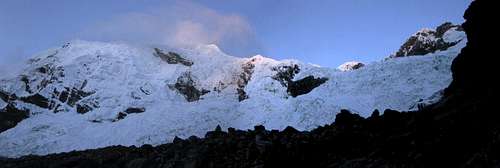
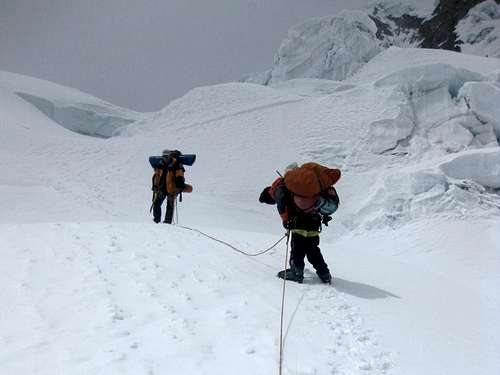
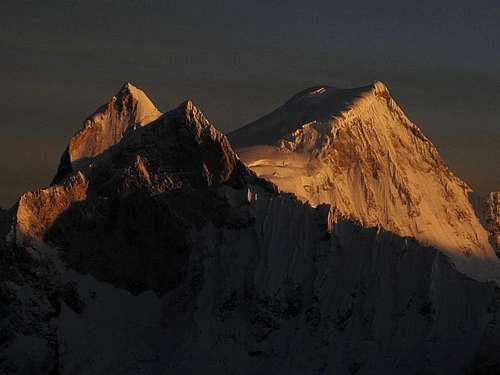
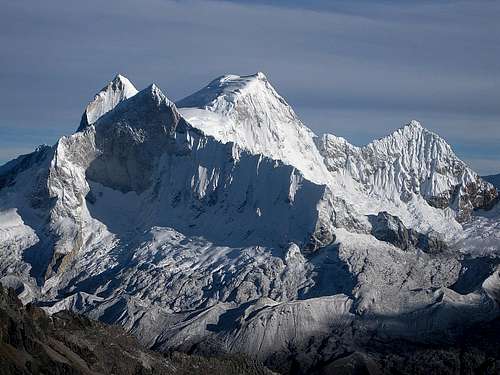
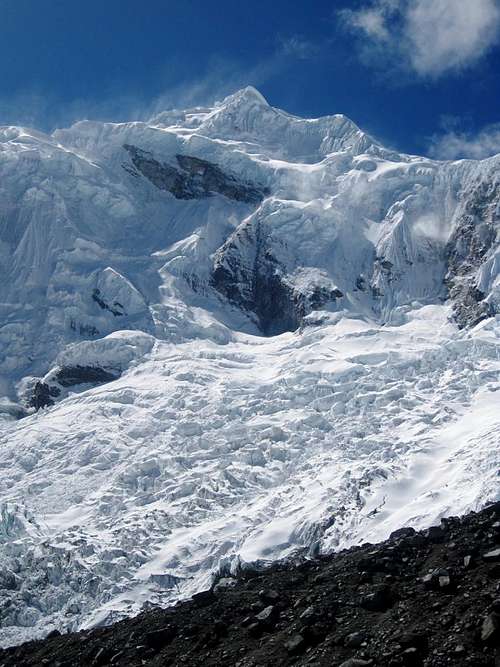





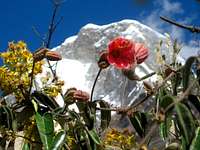

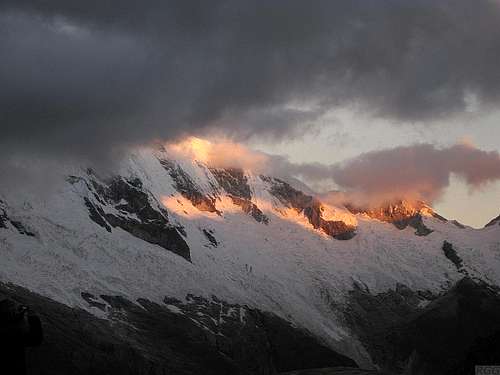



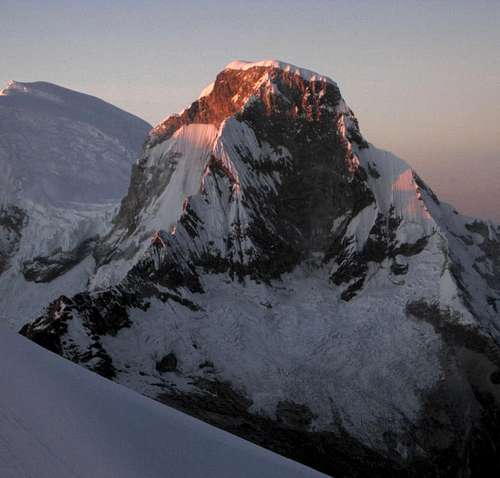
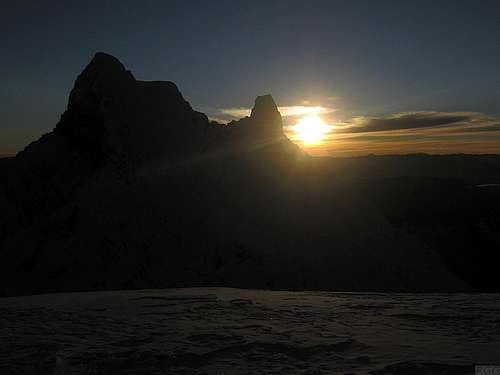
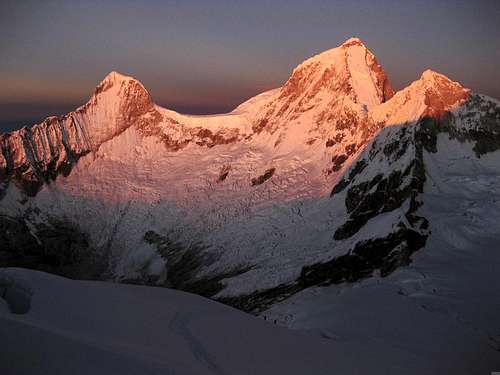
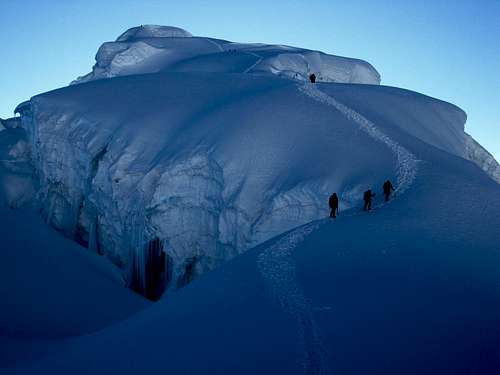
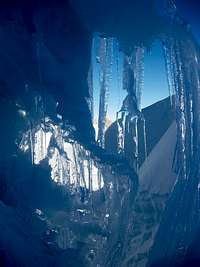




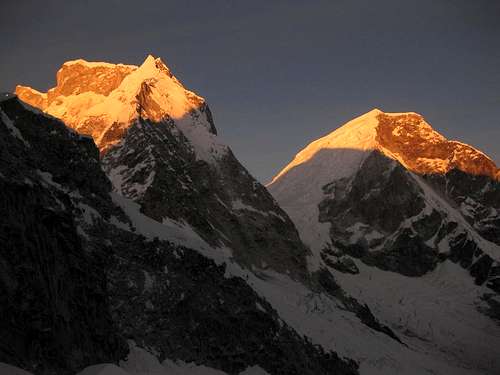



Comments
Post a Comment